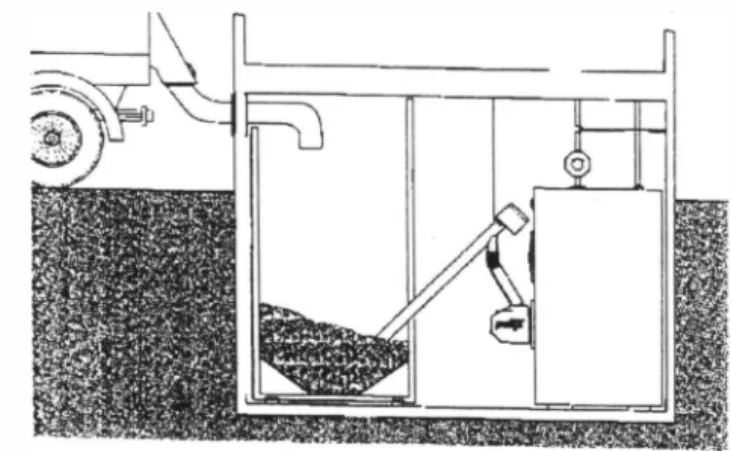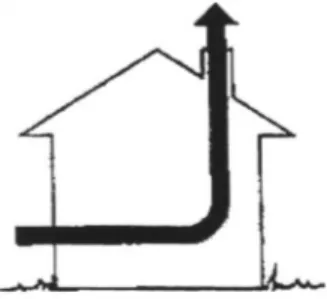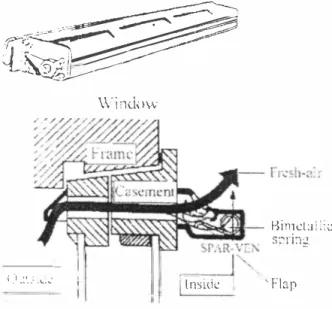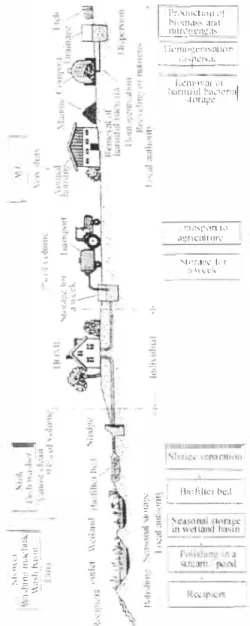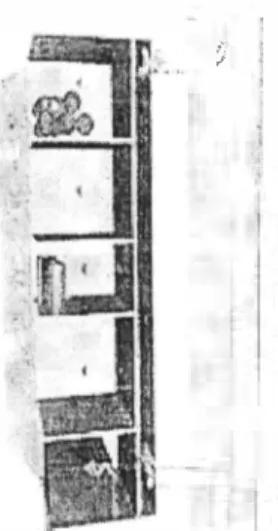6
ECOLOGICAL TECHNOLOGY AND MANAGEMENTKALMAR, SWEDEN, September 22-24, 1999
ECOLOGICAL REATING, VENTILATION
AND SANITARV TECHNIQUE
Lennart Eriksson
IDERIKSON INNOVA TIONA, Sweden
PRESENTATIONResearch and innovations for new building installations is the main activity of my 1 0 year old company, ID ERIKSON INNOVATION Ltd, which I founded with 30 years of practical
experience with technical development and research in leading firms with heating, ventilation and sanitation technologies.
You can find a relatively large number of firms working in the special fields on the Kalmar region. Together with our new University institutions, good complementary resources are available for further development. We are now even examining the possibilities for co-operation abroad. From identifying a problem to developing a well working solution with these types of systems can require a few years of work, especially if you are a bit too early believing in a potential market for ecological minded products, the demand for which has now increased quite dramatically.
Lennart Eriksson, Sweden 65
�
®�"''-�
-�-��-
---_.,-� 1 3f:1
1 � 4---.
iECOLOGICAL REA TING
Wood for heating is growing more and more as a good ecological alternative and complement in many cases. A real old type of stove as far as from the middle age and energy crisis in the last I 00 years have now become more popular than ever. It was already from the beginning very energy saving because of it/s clever extra long channel system in a heavy and good accumulation construction, which can be seen in figure I .
The lack of firewood was then caused of the huge use of firewood for charcoal stacking to supply the iron- and glassworks.
� 1 7 � J (, 1 5 1 4 '-�1 2 1 1 1 0
-'�'-
9s
� 7 - \__ 6<;:i �
-a:,
Ir. ,,
-I:
�t
!l��!
-t
rs 'i ! 1',.!&
�\
J
··----...
1');1
---·
Fig.1 Stove with prefabricated sections
The stoves with its channels were build with small bricks in a very expensive and meticulous fashion. A friend of mine in Kalmar and I invented a new way to build such stoves. Using prefabricated sections, seen at the figure, we could just pile these up in such a way that the complete stove, with all channels, could be assebled much more easily. The production is now in full speed in protection of this patented method (Ref.I).
ECOLOGICAL TECHNOLOGY AND MANAGEMENT KALMAR, SWEDEN, September 22-24, 1999
Pellets are a biofuel introduced in the 80's. They are recyclable and therefore part of natures recycling process. Pellets are the most environmental friendly alternative for heating detached houses, small industrial buildings, farms and in similar applications.
Pellets are primarily manufactured from the by-products from sav.'111ills; the sawdust etc is ground and formed into small sticks. When burning pure wood pellets the ash waste is less than I %. In respect of transportation and storing, pellets are advantageous due to their high energy density great advantages compared to wood handling. Pellets neither freeze nor rot during storage. When heating with pellets the fuel feed to the burner can be automated in
the same way as with oil heating.
Fig. 2 Replenishing of pellets to burner and boiler
ECOLOGICAL VENTILAnTION WITH THE SP AR- VEN-SYSTEM
This year 1 999 is a special year in Sweden for good ventilation in buildings called "Inne 99" ("Inside 99"). Because of that I will start presenting the SP AR- VEN system built up on some of my patents acquired over the past 1 5
years-The fundamental principles of the system for ecological ventilation are described in a report by the Swedish Council for Building Research (ref 1). This report deals with the development of this ventilation system that can be particularly suitable for installation in existing blocks of flats with natural ventilation.
� � �
The obj ect of the proj ect was to develop a well functioning system that can be easily repaired, altered and extended schemes, and which is based on the existing natural ventilation system. In addition. installation and running costs must be low. Furthermore. the system must take up little space and involve little interference with the fabric of the building.
The principal components of the system are automatic temperature controlled inlet air terminals and a special device in the form of a cowl which is placed on top of the ventilation chimney. The complete system eliminates the great drawback of the natural ventilation system which is that air flow rate varies over the year from excessive to nil due to variations in wind conditions and outside temperatures. Another advantage of the system is that a heat pump can easily be added on for recovery of heat from the exhaust air where this is convenient.
ECOLOGICAL TECHNOLOGY AND MANAGEMENT KALMAR, SWEDEN, September 22-24, 1 999
Natural ventilation relies on thermal forces. Warmed air rises and is evacuated from the kitchen and the bathroom via air outlet ducts ending in ventilation chimneys. Fresh air will then force its way into the building around windows and doors or through fresh-air inlets. General problems with natural ventilation systems, due to effect of the out-door temperature, are too little ventilation during summertime and too much ventilation during the winter.
Fig. 4 The SP AR- VEN system overcomes the problems
The SPAR- VEN system has been developed to preserve the principles of natural ventilation, but to ensure an even and sufficient control of ventilation air.
* The system is self-regulating and guarantees a sufficient flow of fresh air through the building. * The system compensates for lack of natural ventilation during summertime and prevents
overventilation during the winter.
* The system relies opon for the recovery of thermal energy from the outlet airn.
-�
�
:L� i
The SPAR- VEN.fresh-air ventilator
Practical tests have been made on the system and its components, both in the laboratory and in the field. Field tests were carried out in consultation with the municipal housing enterprise Kalmarhem in Kalmar, which readily made a suitable block of flats available for the tests.
_;J�
----\V i ndmv
i _l _:1• •: . 1,.. ,.'i
lnsitkKimel,1
i
l:-:
s;,ri:1;
·· Flap
Fig. S Automatic temperature controlled resb-air ventilator
SP AR- VEN system complete
The further development of the SPAR- VEN-system for even greater air need e.g. for use in schools. is shown in documents (ref. 5,6 and 7).
Until now most of the installations have been concentrated to Sweden and the Nordic countries. One majnor demand upon all systems is that the buildings are in acceptable condition especially with regard to their so called climate-shell. From reliable performance of mechanical and quite complicated systems -of ten with problems in function -the interest for developed a simpler system based on natural ventilation has grown to a significallevel.
ECOLOGICAL TECHNOLOGY AND MANAGEMENT KALMAR, SWEDEN, September 22-24, 1999
Heatpumpinstallation ace request
*) The SP AR- VEN fresh-air ventilator. Patented (ref 3)
**) The SPAR-VEN hood molinted on an existing ventilation chimney. Patented (ref 4)
Fig. 6 SP AR- VEN -system complete
RECYCLING OF SEWAGE AT SOURCE
The need far new solutions in this field is now obvious even in Sweden despite our generally law water casts. Especially outside the established urban systems there are problems with growing by contamination of drinking water wells because of bad systems for cleaning sewage. This is even seen as a waste of nutrients.
After collection experiences from quite a great number of other new installations we have identified some critical points. One principal line seems clear: We will treat the generally warm flow from bath, dishes and washing, representing more than 90% of the total flow, in Sweden called "grey-water", separate from the WC-flow, called "black-water". Fig. 7.
With the more water saving systems of today in "black-water" systems perhaps a more adequate name for it is "black-flow". Quite a lot of new "black-flow" systems are now under development allover Sweden and elsewhere.
�. 7J1
C,
:. -�
:;
; =
.!:,� �"7.-··,
ECOLOGICAL TECHNOLOGY AND MANAGEMENT KALMAR, SWEDEN, September 22-24, 1999
Pr,Xhk"l1nn :··� hh1!J1,b:-, ;J!)\\ _!.���i:tnsa, 1 l,·m<1!�1·n1�:u1,1r\ __ 1J .... !1t.:!\,l, -·· El.'.rll'\\':JI l1 1.
l1:1rm1·ut l-;1,:wr:.ij -.1(1raµt·
. ;,1 f�'\ (' � �n I,• il�fit:llilort· '.11'�,,�!l', kr :1\\\,;L'.,-. ·.; Binfilt(r bL\l
ts;-; _____ _
::...Fig 7 Principle solution
The critical points regarding " grey-water" have not been so well penetrated. The problems are
concentrated to the biological treatment including the " gr ey-waters" energy-resource and
especially to the size and waste load at each installation. If possible, we want to handle the problems locally. We then find some interesting possibilities, but even risks and potential problems. "Grey-water" includes undoubted risky pathogens, but not much more however than what is flowing out in a mix from ordinary urban sewage treatment works in general today.
Using a local solution we can utilize the energy content to almost in providing a more efficient treatment. In addition we believe we can arrange for energy savings in two ways: First the rest energy itself and second by using the better transport of energy from deeper soil levels by the vertical filtration. Instead of working with wetland in the first step we will test using garden-beds of soil over clay in special compositions, which would be even better/easier to implement in ordinary garden environments.
As winter-insulation are wooden chips and leaves ment to be used.
At the end of the system is a well for watering and -depending of cleanness -even for other purposes. Fig. 8, especially intensified framed
part-The goal is building up a group of houses and -to start with -calculate its different flows in a hole.
In developing and evaluating the whole system we are working in an interdisciplinary fashion, with experts from horticulture, microbiology, unconventional installation-technique and so on. We now want to invite colleagues and interested companies, especially from countries around the Baltic Sea, to a planned EU-project in this technique and according issues.
�
\�
" >
· -(� Recycli� o�r Arabic land R.csctVoir for ��Treatment of waste and sewage at source with recycling ofheut and water Root: and drainage wnter
� Biological bed
i'l
00 0
;,:r
Soiled_bcd(sand_&clay for Well :,.0
reducbon of nutrients and • Pond r c,
pathogen�.
s:
n
Controlled infihration of
r
"
sewage. Heal c:xchange."
0"r,, ;;j
(')',
:!: ()
a
r�, ____
t'T1 :i: ;,,r :,.► "'oz
t'T1 (>=-"'
�o
. r
Urine/ C,[
:,.[/Jo
p 0 OQ�
.g
- -<
[/J "' Jlush :i;g. z
"
"
watcr Reci ppient/ !1 03 ::, Green area NJ:: ';-':,.
�z
. >---��-I
Recipient/��
j Irrigation
I
Waler course "':i:wintcrstomge (duringgrowmg 14"
season)
__,
FOODSTORING WITHOUT COOL ENERGY
In a system called II Svalan II air is taken down in the ordinary drain-pipe system which surrounds all building foundations, relatively deep in the ground. The airflow will in that way be controlled by the ground temperature, which means around 6-9°C the whole year, a quit useful
temperature for storing i.e. root vegetables.
The thermostated air can either chill a cellar with cupboards or/and a cupboard up in the respectively department. The airflow-system is closed. It works by an exchanger, which means no contact with the food or the house ventilation-system. No contamination is then possible. Possibly radon from the ground, with its cancer risks can be eliminated by evacuation. By high concentration a powerful extraction fan in the system can reduce the risk of radon leaking in to the building. A patent for the system has been applied for. (Ref 5).
t'! /
Fig_ 9 Ground-drilled cupboard
Another piece of equipment for willter storage placed on balconies or patios can be seen on next pictures IO and 11. It is designed as a sofa and made by high-insulated material. Its ventilation adapts to the outside temperature and works together with a small freezing protector (thermostat and 40 W warming strip) in the whole store volume is independent of the degree of filling. Patented (Ref9).
ECOLOGICAL TECHNOLOGY AND MANAGEMENT KALMAR, SWEDEN, September 22-24, 1999
REFERENCES
I. Eriksson L., Masimov T., Westblom S. ( 1986) Blocks and Flats with Controlled Natural Ventilation and Recovery of Heat
Swedish Council for Building Research. Document D 19: 1986 (eng.) 2. Pat. number 8102543-9 in SW.
A
3. Pat. number 7803220-8 in SW and equivalent in NO, DK, F, GB, DE, FR, CA
and US.
4. Pat. number 8306875-9 In SW and equivalent in NO, DK, F, GB, DE, FR, CA, US, BE, CH and AT.
5. Hecktor 8.0., Ramner G. ( 1988) Kontrollerad naturlig ventilation. Utvardering av ell
experimentbyggnadsprojekt. (Controlled Natural Ventilation. Evoluation of an experiment building project)
Swedish Council for Building Research. Document R66: 1988 (sw.)
6.Swedish Council for Building Research (1989) Kontrollerad sjalvdragsventilation.
Flaktforstdrkt system for varsam ombyggnad och nyproduktion. (Controlled Natural Ventilation. Fanreinforced system for careful rebuilding and newbuilding) .Report G 18-1989 (SWa.)
7. Eriksson L. (1997) Sjalvdrag (S), Forstarkt styrt sjdlvdrag (FSS) alternativt Konventionel/
ventilation (FTX), Forstudie med miljo- och livscykelkostnadsanalys i skolor. (Natural
ventilation, Reinforced and controlled natural ventilation alternate Conventional fan ventilation. Preliminary study with environment- and lifecycle-analyses in schools)
Swedish Council for Building Research. Report 970205 (sw .)
